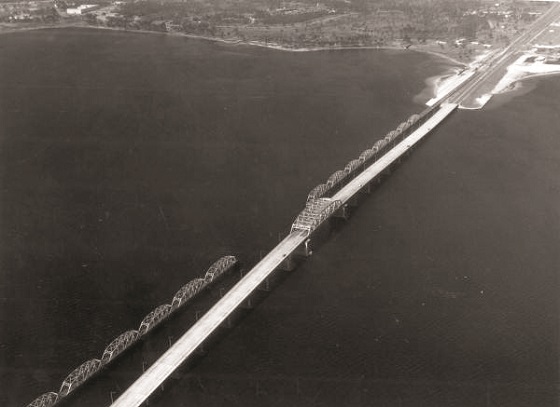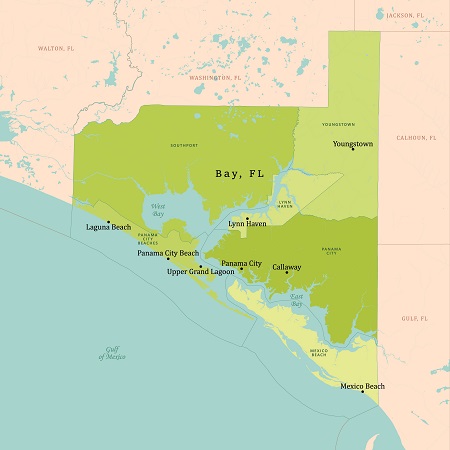The Hathaway Bridge complex in Panama City, Fla., has a long history that includes multiple bridges:
• St. Andrews Bay Bridge: Built in 1929, this bridge was renamed to Hathaway Bridge after Dr. Fons A. Hathaway, the chairman of Florida’s State Road Department at the time. The bridge was a notable engineering achievement for its time, with 16 Parker through-truss spans and a 200-foot (60.9 m) Warren truss swing span to accommodate shipping traffic. The bridge was built alongside the DuPont Bridge to make travel easier and to encourage development in the area. During World War II, the bridge included a bridgetender’s job and was used until 1960.
• Second Hathaway Bridge: Completed in 1959, this bridge replaced the first Hathaway Bridge.
• New Hathaway Bridge: In 1997, Florida allocated more than $80 million to build a new bridge. The new bridge is made up of two segmental concrete box girders with 80-foot-wide (24.4 m) boxes and 330-foot-long (100.6 m) spans.
In the early 2000s, the Florida Department of Transportation (FDOT) determined that touch-up coating work was required on certain areas of the existing Hathaway Bridge structures. The existing structural coating on the affected Hathaway Bridge structures was known to be an acrylic copolymer. An investigation by the FDOT indicated that a single-pack, moisture-cured urethane system was a viable “touch-up and topcoat” system.
Testing in laboratories and on the actual bridge structures involving mechanical surface preparation of exposed substrate areas, spot priming, and subsequent full overcoating using a particular moisture-cured urethane product provided satisfactory results.
An industrial bridge coating application contractor was subsequently hired by FDOT, and work commenced. Nowadays, the Hathaway Bridge sees heavy automotive traffic to and from the popular Panama City Beach area. As such, surface preparation and coating application work were conducted from midnight to 8:00 a.m.
The localized surface preparation and spot priming work went according to the project specification. After the new spot-primed areas cured per the coating manufacturer’s requirements, a full topcoat using the new moisture-cured urethane was applied in accordance with the FDOT specification. The next night, the industrial painting contractor noted large areas of disbondment of the newly applied overcoat from the original acrylic copolymer.
Investigation of the Failure
The investigation of the observed failures was conducted on several fronts.
A review of the FDOT quality control (QC) inspectors’ records revealed that the surface preparation, coating mixing, and coating application followed the FDOT specification, the coating contractor-approved procedures, and the coating manufacturers’ product data sheets.

Preliminary laboratory analyses of failed coating samples revealed no deficiencies concerning the resin and pigment in the newly applied repair coating.
The coating application contractor also conducted a physical examination of the remaining unopened containers of the new moisture-cured urethane coating and noted an anomaly: The containers appeared to have two labels on them — a new label pasted carefully over the original label. The contractor removed the outer label from the old label and determined that both labels were for the manufacturer’s moisture-cured urethane, with slightly different data on them. No reasons for this odd labeling were forthcoming at that time.
What Had Happened?
To understand the double labels on the project coating containers, we need to look at a federal statute known as the Clean Air Act (CAA).
The CAA was originally issued by the U.S. Environmental Protection Agency (EPA) as “42 U.S.C. §7401 et seq. (1970).” CAA is a comprehensive federal law that regulates air emissions from stationary and mobile sources. Among other things, this law authorizes the EPA to establish National Ambient Air Quality Standards (NAAQS) to protect public health and public welfare and to regulate emissions of hazardous air pollutants.
Concerning industrial protective coatings, the CAA sets an administrative limit on volatile organic compounds (VOCs) at 4.5 pounds per gallon (539.2 g/L). Additionally, the CAA requires each U.S. state to issue a law that limits VOCs to no more than that 4.5 pounds per gallon. Most states incorporated the Federal Administrative VOC limit, but others elected to institute lower state law limits.
We will see that this state-by-state VOC limit difference is important in the analysis of this situation, as a solvent had been added to both coating containers.
As various parties involved in some way with the bridge coating failure shared more and more information, several conclusions were able to be drawn.
For starters, the investigation of the “new label over an original label” on the containers indicated that both labels, although different, represented the same moisture-cured urethane product with one significant difference: The original label identified a solvent (aka a thinner) formulation that complies with a 3.8 pounds per gallon (455.3 g/L) VOC content, whereas the new (outer) label identified a solvent (also a thinner) combination that complies with a 4.5 pounds per gallon VOC content.
What Are the Functions of Solvent/Thinner?
Historically, and to this day, most technical people working in the industrial coatings and linings industry, when asked about the function of solvents and thinners in an industrial coating or lining formulation, will respond with the definitions from the “Protective Coatings Glossary (SSPC 00-07),” a widely used 2007 document that is contemporary with the failure discussed in this paper:
• “Solvent — Liquid, usually volatile, used in the manufacture of paint to dissolve or disperse the film-forming constituents. Solvents are used to control the consistency and character of the liquid paint material and to regulate its application properties.”
• “Thinner — A volatile liquid used to improve the application properties of a coating, normally by reducing viscosity. A thinner may be a single solvent or a combination of solvent types.”
Current references and even the Association for Materials Protection and Performance (AMPP), the owner of the glossary, have coatings courses that still reflect these historical characterizations of solvents and thinners.
So, What Happened Here?
My experience has shown that, 90% of the time, coating and lining failures are the result of one of three factors (see more in “A Systematic Approach to Coating Failure Analysis,” CoatingsPro Magazine, Jan. 2021):
1. Someone did something wrong.
2. Someone did something stupid.
3. Someone did something both stupid and wrong.
In the case of the Hathaway Bridge coating failures, diligent investigative work uncovered that:
1. The coating manufacturer had produced and packaged an order of its moisture-cured urethane to be sent to a coating contractor operating in New York State. Note that the state VOC law in New York State at that time was 3.8 pounds per gallon and the coating containers were so labeled.
2. Before shipment, but after packaging, the contractor scheduled to be working in New York State canceled the order.
3. The coating manufacturer concurrently received an order for its moisture-cured urethane to be applied to the Hathaway Bridge. Remember that the VOC law in Florida in the early 2000s was 4.5 pounds per gallon.
Since the product difference was only in changing the amount of solvent in the product, the coating manufacturer then printed new labels identifying the change in solvent amount and applied them over the original container labels. The coating was then sent to the contractor in Florida.
Later, in sworn testimony, the coating manufacturer that provided the double-labeled coating containers stated that his company was fully within its rights to paste a new label over the original label. He testified that because the solvent would evaporate into the atmosphere after the coating application, it thus would have had no effect on the performance of the moisture-cured urethane system.
Also, the 3.8 pounds per gallon VOC of the New York coating formulation was less than the 4.5 pounds per gallon required by Florida statutes, so the manufacturer’s leader believed that his company was compliant with Florida VOC statutes.
So, what caused the touch-up and overcoat system to fail (i.e., disbond) when applied to the existing coating system?
Working with the FDOT staff, we were able to demonstrate that the solvents added by the coating manufacturer in the 4.5 pounds per gallon were able to soften the existing acrylic copolymer system on the bridge and thus facilitate bonding of the newly applied moisture-cured urethane.
It was also discovered by laboratory analyses that the solvent blend in the 3.8 pounds per gallon VOC version of the moisture-cured urethane was significantly different than that of the 4.5 pounds per gallon VOC version of the product.
This difference in solvent blend, although deemed acceptable by the coating manufacturer, resulted in unacceptable adhesion of the newly applied moisture-cured urethane topcoat to the existing original acrylic copolymer coating.
To avoid this type of failure in the future, a coating contractor may be able to do a bit of due diligence up front. Mockups, for example, would have quickly shown that the overcoating with the product actually received at the jobsite would have a negative reaction when applied to the existing coating system. Proper systems and processes in place to evaluate and correct any errors with container labels also could have prevented these issues.

Dedication
This article is dedicated to my client and friend, Nancy Jean Aliff, LLD, who passed away unexpectedly on January 28, 2012. Nancy served as a special counsel for the Florida Department of Transportation, and I had the privilege of working with her on several matters.
She was the FDOT Special Counsel assigned to the coating failure case described in this “Never Again” article.
Editor’s note: This article first appeared in the September 2024 print issue of CoatingsPro Magazine. Reprinted with permission.